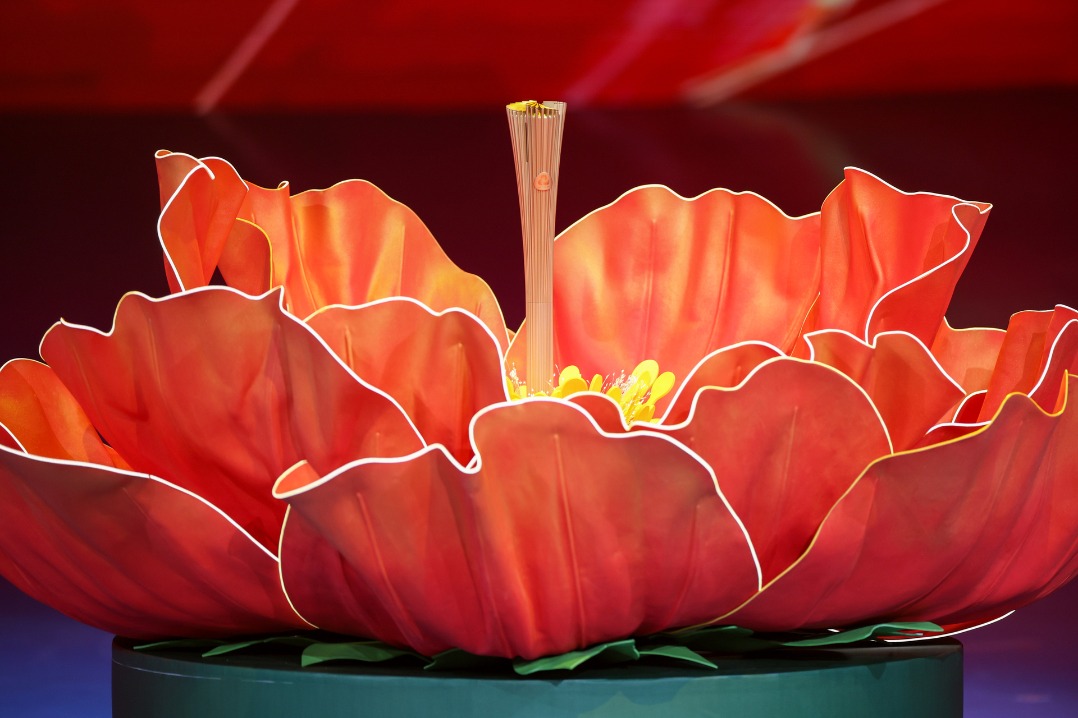An enlightened man
An exhibition featuring the surviving works of Wen Yiduo, an early leader of the China Democratic League and the poet famed for Songs of Seven Sons, is taking place in Beijing, Fang Aiqing reports.

An exhibition held in Beijing reveals the fine art talent of a modern Chinese poet and patriot of the early 20th century who is widely regarded for his literary achievements and heroic sacrifices.
It also sheds light on how a close circle of intellectuals of the time shared a high level of academic and cultural attainment that went on to lay the foundation of today's contemporary art and cultural practices.
Wen Yiduo (1899-1946), one of the early leaders of the China Democratic League, was shot dead in Kunming, Southwest China's Yunnan province, on July 15, 1946, during the civil war.
He died just several hours after he stood up at a memorial assembly to defend his fellow league member Li Gongpu, who was assassinated several days earlier, and openly criticizes his murderers-agents of the Kuomintang-and called for peace and democracy.
In memory of the 120th anniversary of Wen's birth, the exhibition at the Chinese Academy of Oil Painting, affiliated to the Chinese National Academy of Arts, running through Tuesday presents a variety of works, from book cover designs and illustrations, to seal cutting, calligraphy and sketches, as well as letters to his family and enlightened circle of friends.
The letters, in the eyes of his youngest son Wen Lipeng, convey an intellectual's reflections on Chinese culture, his struggle over whether to apply Western or Chinese cultural concepts to his work and his personal ambivalence toward making career choices.
Most of Wen Yiduo's artworks have been lost in those years of unrest over the first half of the 20th century, but the surviving ones-most of which are currently on display at the academy-demonstrate an integration between the Western and Eastern concepts of art and a combination of the traditional and modern artistic styles.
And they have also served to enrich the image of one of the all-rounders among the intellectual elites typical of this era in modern Chinese history.
One of Wen Yiduo's most famous pieces of poetry, an excerpt about Macao from a seven-piece suite of verse, became a household name when China resumed its sovereignty over Macao in December 1999. The verse was adapted to become the theme song for the event which was popularly sung throughout the country that year.
In the suite titled Songs of Seven Sons, he compared seven places including Macao, Hong Kong and Taiwan that were among China's ceded or leased territories to seven sons that were deprived of their mother.
The suite was created in March 1925, during Wen Yiduo's stay in the United States. A less well-known fact is that he was the first student from Tsinghua Xuetang-the predecessor to Tsinghua University-to study fine art in the US.
At that time, it was a preparatory school for students who would later be sent by the government to study at universities in the US.
Wen Yiduo went on to study successively at the School of the Art Institute of Chicago, the University of Colorado and the Art Students League of New York from 1922 to 1925.
Despite his outstanding academic performance, he returned home before his graduation and devoted his time mainly to theater, poetry and the study of Chinese ancient literature as he pondered China's future.
The renowned writer and historian Guo Moruo (1892-1978) once commented: "He studied history to criticize it and delved into the bowels of the past to sublate it. He continued to dig purposefully only to reach the other side with his aims still at the forefront of his mind."
Wen Yiduo made his first foray into art at Tsinghua in 1921 as a graphics editor of an oddly named yearbook titled, Tsinghuapper, where he drew 12 illustrations, the bookplate, an advertisement and most of the decorative patterns. He had yet to get any professional artistic training back then.
In one of his Beardsley-style illustrations, he drew a maiden dreaming of blossoms growing out of a pencil-mirroring an ancient Chinese fable-as she sleeps at a desk by candle light.
The image highlights the use of Western perspective and drawing techniques combined with traditional Chinese line drawing techniques and approach to present artistic concepts. The latter was often applied to traditional Chinese woodcuts.
With its group photos and member lists of student associations-from an art society and a glee club to a brass band-the yearbook offers a glimpse of a time where groups of intellectuals, renowned both then and now, actively demonstrated their versatile talents.
For example, architect and architectural historian Liang Sicheng served as the major of the brass band and a member of the glee club.
Curator of the exhibition Wen Danqing, one of Wen Lipeng's sons, is impressed by one of the chapters in the yearbook, named For the Neighbor, in which the authors list the students' social volunteer work and their extensive efforts to care for those in the lower strata of society.
They set up night schools and libraries for coolies, servants, villagers, scavengers and other members of the poor and needy.
The curator believes these kinds of social services contributed to the students' devotion to the country and the people in later life.
Wen Yiduo not only designed covers for his own poetry collections like Red Candle and Dead Water, but also for works by his friends, like renowned authors Xu Zhimo and Liang Shih-chiu.
On the cover he designed for Xu's last poetry collection, The Tiger, which includes his most famous work On Leaving Cambridge Again, Wen Yiduo merged the front and back covers into one freehand, abstract depiction of a tiger skin using Chinese brush strokes.
In 1927, he created the cover for sociologist Pan Guangdan's psychological research work on the Ming Dynasty (1368-1644) woman Feng Xiaoqing, who, as a concubine banned from seeing her husband by his first wife, was frequently seen staring into a mirror in self-pity.
The composition, the shape of the figure and the hues in this compassionate drawing all employ Western art techniques, but are used to reflect a woman's misfortune in feudal ancient Chinese society.
"The forte of that generation lies in their excellence in Sinology, combined with their mastery of the cutting-edge academic, art and cultural achievements of the West, and the era provided them with the groundwork to give full scope to their talents," says Wen Danqing.
Also on display are calligraphy works by Wen Yiduo. He wrote in a kind of ancient hieroglyphic font called guzhouwen to transcribe the coeval The Book of Songs, the earliest collection of Chinese poetry in existence that dates back to between 11th and 6th centuries BC.
His interest and gift for ancient Chinese characters and calligraphy can also be seen in his 500-plus seal cutting works mostly created in the three years before his death to make ends meet.
"The goal of Wen Yiduo's research was to revive the ancient glory that was partly fossilized in the minds of modern people," says his peer, writer Zhu Ziqing.
He also sketched 36 works during the War of Resistance Against Japanese Aggression (1931-45), on his 1,700-kilometer walk to Kunming from Changsha, Hunan province, in 1938 to join the National Southwest Associated University-a wartime union of top Chinese universities and scholars.
He worked as a professor of Chinese literature at Tsinghua right before the war.
The poet and artist once confessed to his friends, "I would rather be a preacher of art than a creator". The perspective of cultural history and the aesthetic ideas embedded in his art pieces are consistent with those of his works of poetry.





Today's Top News
- Chengdu gearing up for World Games
- China, Nepal to strengthen bilateral ties
- Schoolgirl swimmer shines at worlds
- Interest in vocational programs surges
- Robust policy support to propel growth
- US putting its old-generation chips on Chinese table in a bid to stop Ascend






























